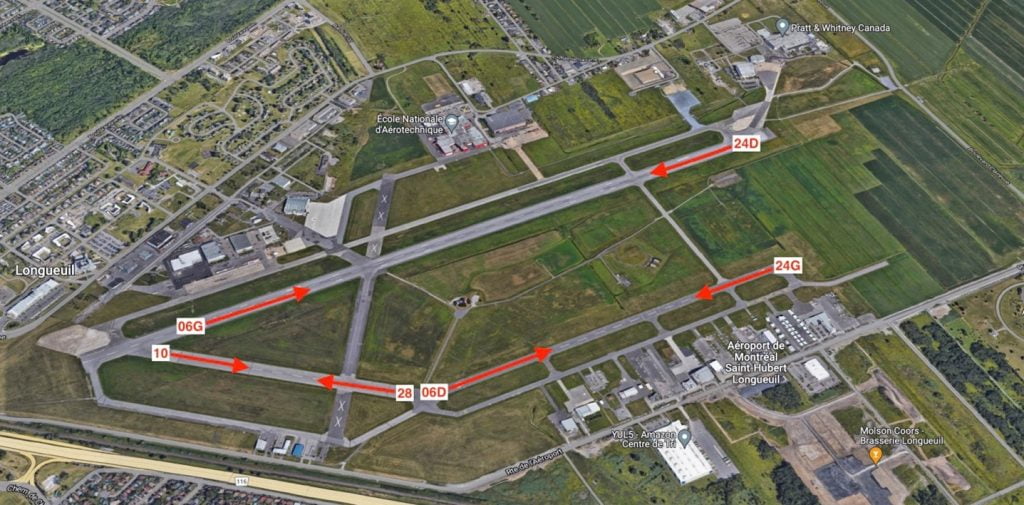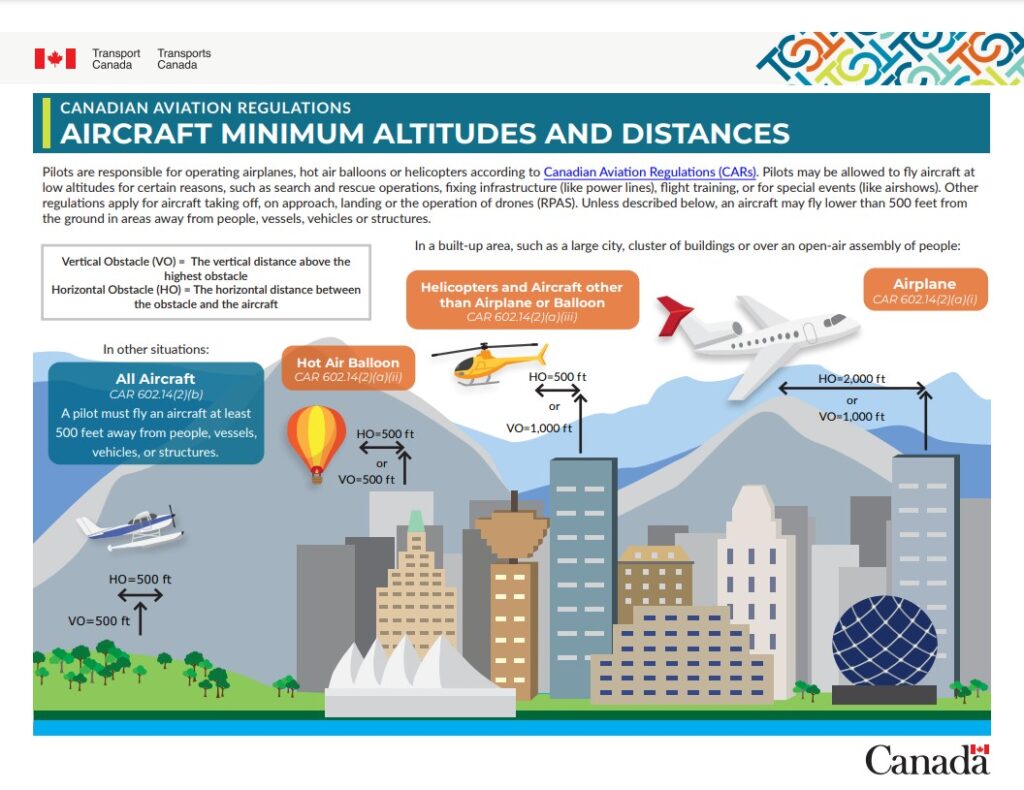FAQ
The non-profit organization, Développement aéroport Saint-Hubert–Longueuil (DASH-L) owns the airport entirely and exclusively. It was transferred to this organization by Transport Canada (TC) on September 1, 2004.
DASH-L and its employees manage the airport.
Like all airports in Canada, the airport is open 24 hours a day, 365 days a year.
The companies on the airport grounds offer scheduled regional passenger flights, flight training for future pilots, charter flights (companies, sports teams, musical groups, etc.), emergency medical flights, civil security, customs and catering.
The airport has six runways.

The runways are designated according to compass orientations. Runways in one direction are the reciprocals of those in the other direction, i.e. +180°. 06 left (06L) and 06 right (06R) face 060˚ (north-east), while 24 left (24L) and 24 right (24R) face 240˚ (south-west), i.e. the other end of the 06 runways.
For physical (and safety) reasons, aircraft take off and land into the wind. The air traffic control unit, such as NAV CANADA in the control tower, determines the active runway, depending on the wind or circumstances.
The main factor is the wind. Aircraft take off and land into the wind. We invite you to consult pages 5 to 7 of our Soundscape Policy document on our website:
https://metmtl.com/wp-content/uploads/2022/01/Politique-du-climat-sonore-YHU-finale.pdf
Both refer to the same airport in St-Hubert. YHU is the three-letter acronym assigned by the International Air Transport Association (IATA), and CYHU is the acronym of the International Civil Aviation Organization (ICAO), a United Nations agency based in Montreal.
An air movement is a take-off or a landing. A plane that takes off is a movement; one that lands is another movement. If the same plane takes off and later comes back to land, this counts as two air movements.
The average varies according to many parameters. However, before COVID, the average was about 400 daily air movements.
Yes, some days are busier depending on the season, weather or operational needs.
The Aeronautics Act (exclusive federal purview), from which the Canadian Aviation Regulations (CARs) main document is derived as well as other regulations such as those regarding airport zoning. All are under exclusive federal purview.
From a physical point of view, the difference lies in the number of seats, power, number and type of engines. From the aviation activity regulation point of view, there is no difference apart from the type of operation in progress (aerial work, taxi, charter, scheduled transport, training, etc.).
The airport can accommodate aircraft with a wingspan of up to 36m that can carry about 200 passengers.
According to the World Health Organisation, noise is any sound or set of sounds considered undesirable; unwanted sounds, those that are disturbing, or sounds whose intensity is likely to cause adverse health effects. Thus, sounds that are unpleasant, discordant or interfere with the reception of a desired sound become noise.
The city developed around the Saint-Hubert airport, the first civilian airport established in Canada in 1927.
Aircraft have two main sources of noise: engine noise and aerodynamic noise. The first is generated by the combustion of the engine, whether it is a turbine or piston engine. Where smaller aircraft are concerned, this noise can be minimized by adding silencers, as was done on training aircraft in 2016 at the MET – Montreal Metropolitan Airport.
Both small and large aircraft also generate aerodynamic noise, which consists mainly of the noise of the propellers and turbines. Also, in the case of larger aircraft, the air comes into contact with a larger surface of the aircraft during take-off stages to create lift or slow the aircraft down with resistance on landing (flap extension).
Environmental noise is measured with a sound level meter and reported on a logarithmic scale, usually in A-weighted decibels (dBA). On this scale, 0 dBA is the threshold of human hearing, while 120 dBA is the threshold of pain. The human ear can detect sound changes of 3 dBA and an increase of 5-10 dBA is generally perceived as a noise twice as loud.
Noise can be measured instantaneously or over a set period, such as an hour or a day. An instantaneous measurement will simply be accompanied by dBA units (e.g., 70 dBA). A one-hour measurement will be noted as LAeq,1h (e.g., 55 dBA LAeq,1h) and a one-day measurement, LAeq,24h. Note that a measurement over a set period usually consists of higher and lower instantaneous measurements. For example, an LAeq,1h could have been calculated from instantaneous measurements ranging from 32 dBA to 75 dBA.
Here, it would be more appropriate to talk about the perception of noise because the temperature, time of day, winds or air density – especially when windows are open or people are outside – give a different impression of aircraft noise.
When necessary, it is measured by specialized firms that use the latest technology. There are no constant measurements like at Montreal—Trudeau Airport.
There are training aircraft, multi-engine aircraft, private jets of all sizes, medical evacuation aircraft and a few other airliners such as 737-800s and Airbus 319s or 220s. There are also Sûreté du Québec, Air Médic and Armed Forces helicopters. There is no helicopter training school at YHU.
In general, it would seem so, as engines are at full power at take-off whereas during landing they may be working at lower power, depending on the type of flight or aircraft.
It is always possible. Saint-Hubert airport has all the regulatory clearances for night flights, like many airports in Canada. However, there may be some restrictions, such as those related to training (touch-and-go maneuvers).
Yes, absolutely. And all the regulations are strictly followed and set out in the Canadian Aviation Regulations (CARs) documents; Canada is recognized worldwide for its safety standards.
The SAC was established in 2015; its mission is to “promote the exchange of information and provide a forum for discussion and consultation on all matters relating to the soundscape, and in particular, on acoustic criteria and noise mitigation procedures to improve the soundscape at the Airport.”
They are appointed by DASH-L. As of 2022, the SAC has at least three members representing citizens from neighbouring municipalities.
As is the case for all Canadian airports, Transport Canada (TC) regulates the airport’s activities. DASH-L and airport operators may apply certain business decisions as long as these decisions do not contravene or interfere with federal government’s purview.
For safety reasons, aircraft (pilots) are not free to fly anywhere they wish and must follow specific routes to and from the airport to avoid conflicts.
Air corridors are preferential routes used for safety purposes. These routes are decided by air traffic control (NAV CANADA) and TC and are reviewed regularly by users (Soundscape Advisory Committee).
“Operating and developing the airport and the airport area as a whole” (“Exploiter et développer l’aéroport et la zone aéroportuaire dans son ensemble”) For more information, visit this webpage: https://metmtl.com/en/about-us/
The members of the Board of Directors are appointed by the:
City of Longueuil
CCIRS: Chambre de commerce et d’industrie de la rive-sud
AQTA: Association québécoise du transport aérien
COPA: Canadian Owners and Pilots Association
ATAC: Air Transport Association of Canada
They are listed on our website: https://metmtl.com/conseil-dadministration/
YHU is the name of the airport; DASH-L is the entity that manages it.
The training, piloting and technical units are listed on the website: https://metmtl.com/en/our-flight-schools/
A landing-controlled touchdown followed by a take-off.
Yes. For several years, the vast majority (95%) have been equipped with a silencer. The exceptions are the models for which there is no certification.
Canadian Aviation Regulations (CARs), Section 406: https://lois-laws.justice.gc.ca/eng/regulations/SOR-96-433/page-37.html
One (1) knot is one (1) nautical mile/hour. One (1) nautical mile is the distance equivalent to one (1) minute (1/60 degree) of latitude or 1,852m. One (1) knot is therefore equivalent to a speed of 1.852 km/h.
They are flying the inbound and outbound routes from the YHU area, as prescribed. Please see pages 5 to 7 of our Soundscape Policy document on our website:
https://metmtl.com/wp-content/uploads/2022/01/Politique-du-climat-sonore-YHU-finale.pdf
These are busy periods for schools or business aircraft. Some flights are also strictly limited to visual flights, which can only take place during fair weather.
Visual flights are restricted to the fairest days when visibility is good. Moreover, aircraft take off and land into the wind. Upwind, it may seem that there are more planes during take-offs; downwind (on landings), it may seem that there are fewer planes.
The French text for very difficult to read and decipher. The English is an adaptation of the text and must be validated.
In fact, statistics show a decline in traffic over the last ten years. There was a clear dip during the COVID pandemic, followed by a return to the average rate of about 300-400 daily air movements.
No. This term doesn’t exist in the regulations.
Nighttime operations are a sensitive issue for many airports around the world and in Canada. For the hundreds of aerodromes and airports across the country, it is up to the operators and airlines to limit their operations to respect the surrounding neighbourhoods.
At the MET – Montreal Metropolitan Airport, night flights are exceptional and limited to special situations. YHU takes a very cautious approach by encouraging mainly daytime flights, such as hosting low-cost carriers that offer daytime flights to serve their customers.
TC is the regulatory body that grants NC the management of air navigation across much of the country. Air movements and everything that happens in the skies over the MET – Montreal Metropolitan Airport control zone are governed by the Canadian Aviation Regulations (CARs), and NC enforces them.
By visiting:
https//yhu.ca/en/file-a-noise-report/
They are examined comprehensively, and if they are specific enough, corrective action can be taken to improve noise levels or the environment.
As many complaints as individuals wish to submit.
As far as possible, yes. If they’re specific enough to take corrective action or improve noise levels or the environment, certainly.

